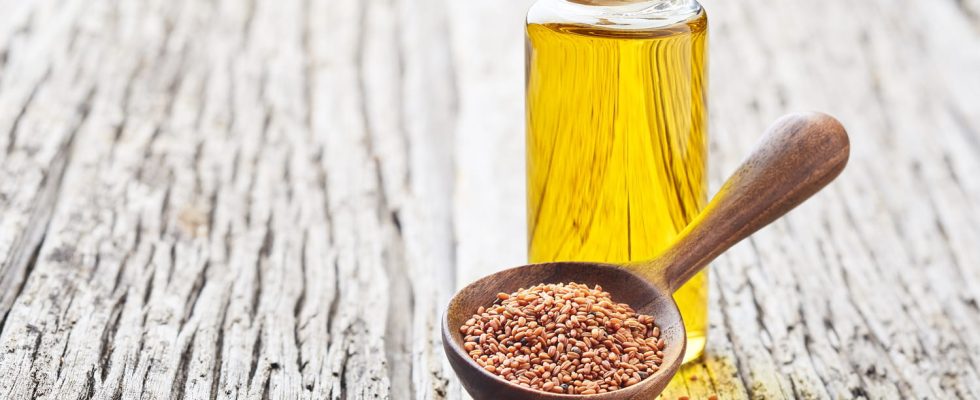Champion of vegetable oils by its omega 3 content, camelina oil has many health benefits. It can be used both orally, raw, in the kitchen and externally for the skin and hair.
What is camelina oil?
“We have been witnessing a strong comeback of the camelina since the 2020s“, emphasizes Jody Elleaume, herbalist and naturopath. It is a very old plant of the Brassicaceae family, such as rapeseed. “In Asia, camelina was used for animal fodder in agriculture. In France and Germany, it was also used to feed livestock.“This plant is quite hardy and strong. “Camelina oil is therefore a vegetable oil which is characterized by its composition rich in saturated fatty acids and particularly in omega 3 with an average of 40% “It is between linseed oil and hemp oil, however it is more fragile than linseed oil. “On average, once opened, it will keep for 6 months.
What are the benefits of camelina oil?
“Camelina oil has general health benefits“, insists the naturopath. It is used both in feeding orally and externally through the skin for the production of cosmetics in synergy with other oils such as jojoba or argan. “She maintains and maintains the health of the nervous system. Our brain can indeed be like a big lump of butter that will draw on saturated fatty acids of omega three to improve its impermeability..” Camelina oil is also a good preventive against cardiovascular disorders. Regular consumption guarantees both a good emotional and moral, physical and psychological balance, helping to combat stress and anxiety. “I particularly recommend it in salads, which it adds to its taste of sesame and asparagus.”
Camelina oil for hair
“Camelina oil because of its content in vitamins A and E is an excellent antioxidant“, continues Jody Elleaume. It is particularly suitable for hair care, especially as “leave-on hair mask about ten minutes.” It makes the hair shinier and more supple.
It prevents intestinal disorders
Camelina oil for the skin
“Camelina oil is interesting for the skin in skin care“. Given its antioxidant content, it helps relieve inflammation of the skin. “Its texture is pleasant, its touch is fresh, it is nourishing and penetrates the skin well.” It can be used alone or in combination with other vegetable oils in daily facial care, “both for mature, atopic, dry, combination or oily skin.“In addition to reinforcing the suppleness of the skin, it has anti-wrinkle action which explains why it is acclaimed by women.
What are its dangers?
Camelina oil is eaten raw, it can never be cooked“because cooking generates health risks with the creation extremely carcinogenic hydrocarbons.“Furthermore, she does not present”no identifiable dangers, no allergic potential both in food and cooking.“His only negative point remains its fragilityrecognizes the specialist.
Is it bad for the intestines?
Quite the contrary! “Thanks to its regulating properties, it prevents intestinal disordersfight against constipation and other digestive pathologies linked to stress”. It is therefore extremely beneficial.
“It is used in the kitchen in the salads always raw in vinaigrette for example, its taste is not too strong in intensity and it can replace sesame or nut oils for those who are allergic.” In skin care, simply apply a few drops and massage until the oil penetrates. For hair, “1 tablespoon of oil will allow you to make your mask”.
Purchase and price of camelina oil
Camelina oil is found in organic stores in the cosmetics and kitchen departments. “Quality varies of course, so beware“A low-end organic camelina oil will cost”on average 5 euros for 100 ml while a high-end camelina oil with real nutritional benefits will cost around 10 euros for 30 ml” concludes Jody Elleaume.
Thanks to Jody Elleaume, herbalist and director of a naturopathic training organization, member of the SPN office (Union of Naturopathic Professionals).
